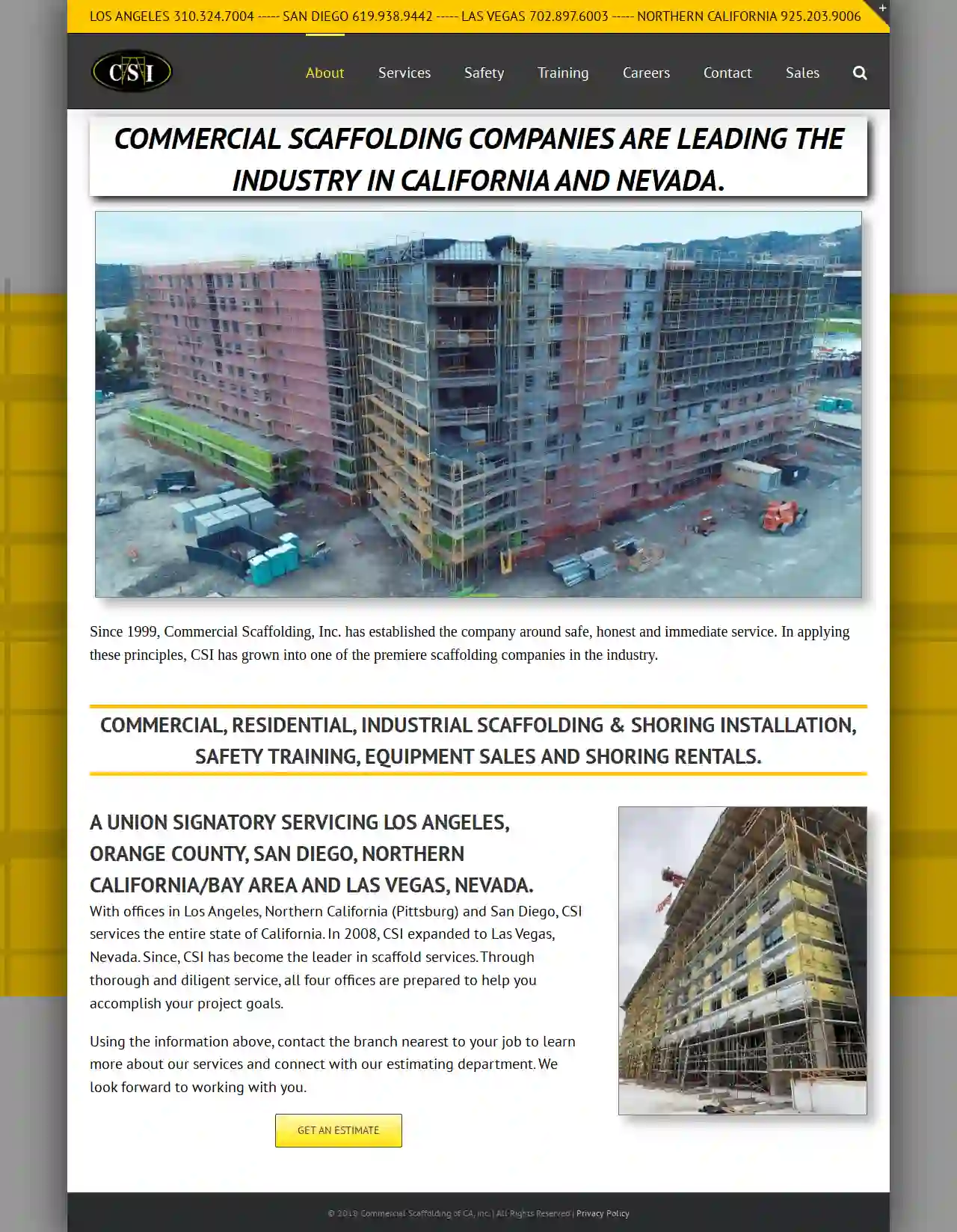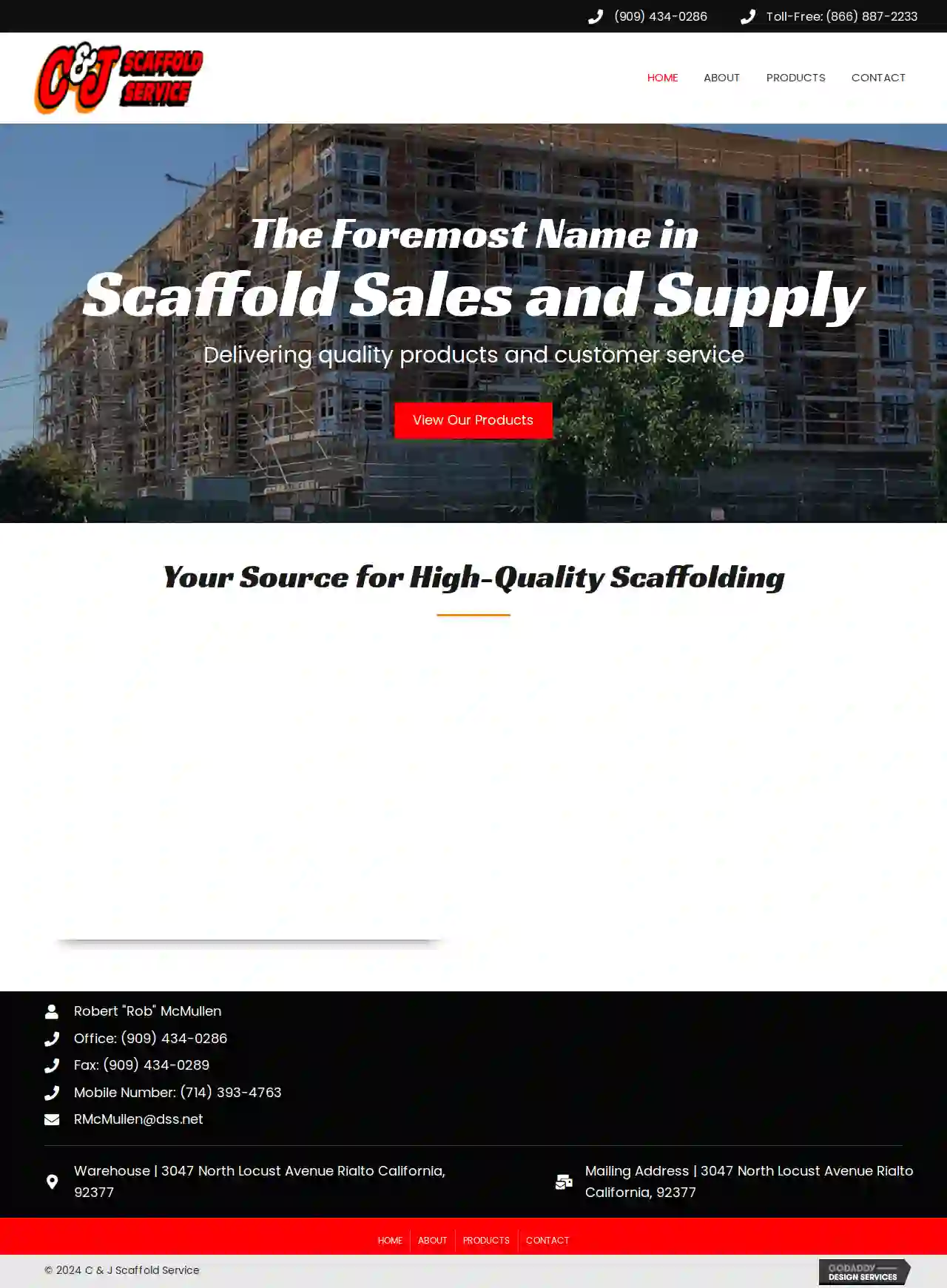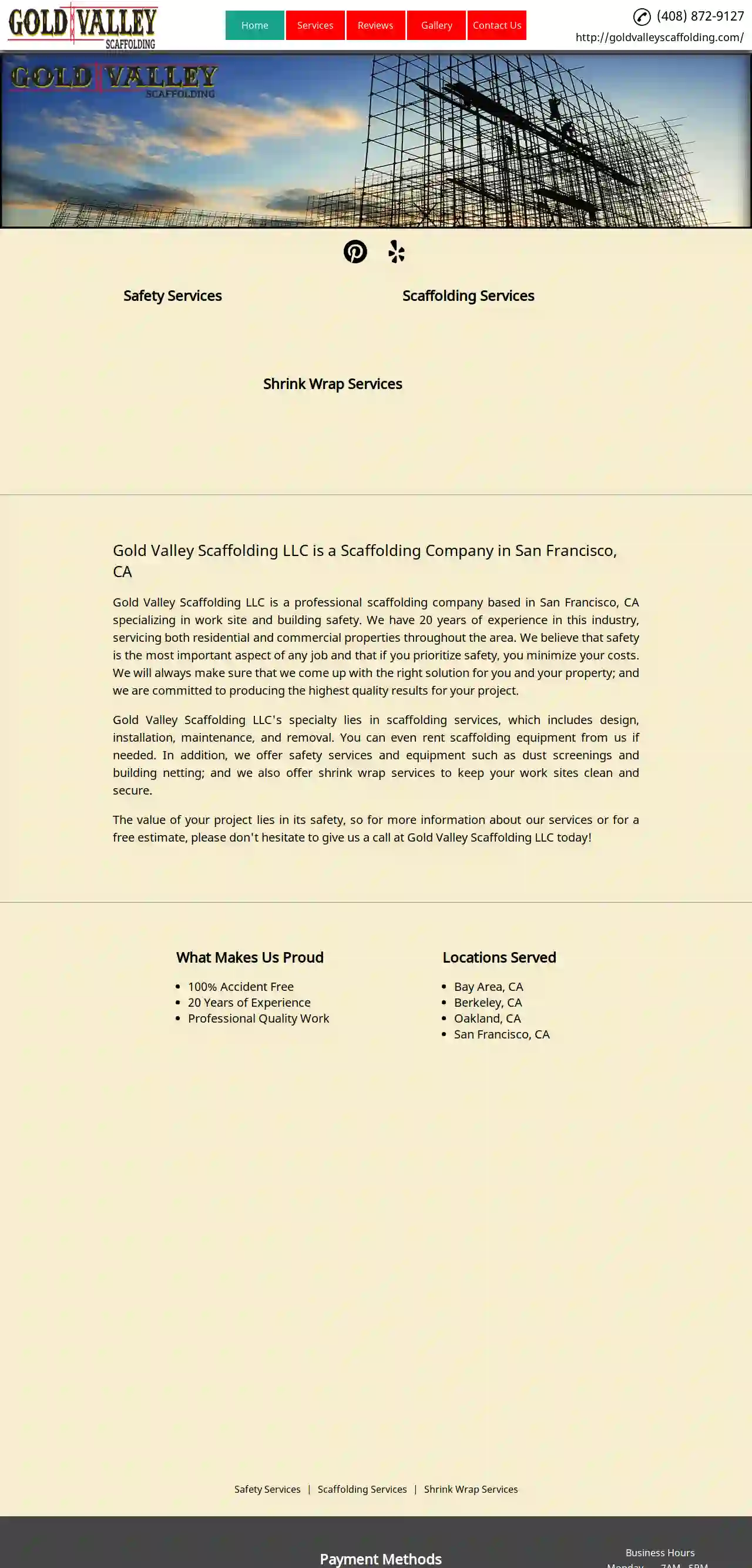Scaffolding Companies South El Monte
Find top Scaffolding Solutions in South El Monte
Get up to 3 Scaffolding Contractors quotes for your project today! Compare profiles, reviews, accreditations, portfolio, etc... and choose the best service.

Commercial Scaffolding of CA, Inc.
4.54 reviewsLos Angeles, USAbout Commercial Scaffolding, Inc. Since 1999, Commercial Scaffolding, Inc. (CSI) has been a leading provider of scaffolding services in California and Nevada. We are committed to providing safe, honest, and immediate service to our clients. This commitment has allowed us to grow into one of the premier scaffolding companies in the industry. We offer a wide range of scaffolding and shoring services, including: Commercial scaffolding Residential scaffolding Industrial scaffolding Shoring installation Safety training Equipment sales Shoring rentals We are a union signatory and serve the following areas: Los Angeles Orange County San Diego Northern California/Bay Area Las Vegas, Nevada With offices in Los Angeles, Northern California (Pittsburg), and San Diego, CSI services the entire state of California. In 2008, CSI expanded to Las Vegas, Nevada. Since then, CSI has become the leader in scaffold services. Through thorough and diligent service, all four offices are prepared to help you accomplish your project goals. Contact the branch nearest to your job to learn more about our services and connect with our estimating department. We look forward to working with you.
- Services
- Why Us?
- Our Team
- Gallery
Get Quote
DIRECT SCAFFOLD SUPPLY
4.811 reviews3047 North Locust Avenue, Rialto, 92377, USWelcome to C & J Scaffold Service, the foremost name in scaffold sales and supply of all scaffolding-related products. With over 50 years of combined sales and technical experience in the scaffolding industry, we strive to provide you with the best in commercial-grade products, competitive pricing, and unmatched service and reliability. Our goal is to make sure your scaffolding needs are met and you are able to complete your project safely and with the best of equipment. We offer a full line of scaffolding and accessories, including scaffolding frames, cross braces, guard rail, guard posts, safety gates, base plates, screw jacks, folding trestles, extensions, tuffy jacks, flat backs, rolling scaffold units, aluminum hook plank, hatch decks, laminated and southern yellow pine plank, MFS scaffolding products, pins, casters, wheels, pulleys, manufacturing parts, locking devices, side brackets, safety signage and stickers, veneer frames, steel tubing, stairways, ladders and brackets, post shores, debris and safety tarps/netting, trash chutes, and systems scaffolding products to include ring lock, cup lock, and tube lock styles.
- Services
- Why Us?
- Accreditations
- Our Team
- Gallery
Get Quote
Power Scaffold Service
4.52 reviews157 East Terrance Way, Bakersfield, 93307, USAt Power Scaffold Services, we build long-lasting relationships with our clients by working closely with them to understand and anticipate their needs. We provide cost-effective solutions that enable our clients to complete their projects safely, on-time, and according to plan. Our top-notch, versatile team has erected and dismantled scaffolds for hospitals, theaters, restaurants, oil refineries, power plants, chemical plants, cement plants, and water treatment plants using our state of the art, long-lasting, and durable Cup-Lock Scaffold System.
- Services
- Why Us?
- Accreditations
- Gallery
Get Quote
Steel City Scaffold
1234 Main St, Los Angeles, CA, 90001, USSteel City Scaffold, Inc. is a commercial and industrial scaffold company specializing in providing top-notch scaffolding solutions to clients in Central and Southern California. With a focus on safety, quality, and excellence, Steel City Scaffold offers a wide range of scaffolding accessories including Canopy, Stair Towers, Re-shoring, Handrailing, Trash Chutes, and more. As a member of the SAIA since 2010, Steel City Scaffold understands the importance of setting safe scaffolding and offers 'Scaffold Awareness Training' to ensure users working on scaffolding understand and recognize safety hazards. Steel City Scaffold, Inc. is committed to providing immediate response, quick turnaround, and excellent customer service.
- Services
- Why Us?
- Accreditations
- Our Team
- Testimonials
- Gallery
Get Quote
OC Construction & Consulting, Inc
4.726 reviews2277 Harbor Blvd, Ste 317, Costa Mesa, 92626, USOC Construction and Consulting, Inc. is a licensed full-service remodeling and construction management company in Orange County, located in Newport Beach, CA. With over 30 years of experience in construction and general contracting, we aim to make the commercial and home remodeling process hassle-free for our clients. Our team of skilled professionals is dedicated to providing exceptional service and quality craftsmanship that exceeds expectations. We understand that every client has unique needs and preferences, which is why we take a personalized approach to each project.
- Services
- Why Us?
- Accreditations
- Testimonials
- Gallery
Get Quote
Major Scaffold, Inc.
55 reviews2908 E Hullett St, Long Beach, 90805, USMajor Scaffold, Inc. is a leading provider of scaffolding solutions in Southern California. With over 25 years of professional experience, the company is dedicated to providing quality services and building valued working relationships with its customers. Their commitment to safety, quality, and quick response service sets them apart from competitors. They offer a wide range of scaffolding solutions including frame scaffolds, pin lock systems, shoring, platforms, stair towers, rolling scaffolds, pedestrian canopies, netting containment, shrinkwrap containment, and trash chutes. Their team is experienced and dedicated to solving everyday scaffolding needs efficiently and effectively.
- Services
- Why Us?
- Accreditations
- Our Team
- Testimonials
- Gallery
Get Quote
Alufase Scaffold USA
51 reviews14144 Market St., Walnut Grove, 95690, USAt Alufase Scaffold USA, we provide high-quality aluminum scaffolding solutions for various industries. Our commitment is to deliver flexible and adaptable products that work in numerous environments. We're dedicated to providing the best products to meet your current needs! Our scaffolding services include sales and rental of aluminum scaffolds, which are an essential resource for several industries. We produce scaffolds of various sizes, shapes, and designs with lightweight metal to ensure you have the strongest product possible. We also offer fiberglass scaffolds as a suitable alternative to different metals for your scaffold, especially when working in potentially hazardous conditions. Additionally, we provide transfer services to ensure you receive your scaffold where you need it when working with our team.
- Services
- Why Us?
- Gallery
Get Quote
Gold Valley Scaffolding LLC
51 reviews123 Main St, San Francisco, CA, 94124, USGold Valley Scaffolding LLC is a professional scaffolding company based in San Francisco, CA specializing in work site and building safety. We have 20 years of experience in this industry, servicing both residential and commercial properties throughout the area. We believe that safety is the most important aspect of any job and that if you prioritize safety, you minimize your costs. We will always make sure that we come up with the right solution for you and your property; and we are committed to producing the highest quality results for your project.
- Services
- Why Us?
- Accreditations
- Our Team
- Testimonials
Get Quote
OLYMPIQUE Scaffold Inspection and Testing
3.73 reviews26429 Rancho Parkway South, Suite 145, Lake Forest, 92630, USOLYMPIQUE Facade Access Consulting is a leading provider of facade access consulting services, including new construction consulting and design, existing building consulting and design, and scaffold inspection and testing. With years of experience in the industry, our team of experts is dedicated to providing top-notch services to our clients. We are fully accredited and insured, and we maintain a Cal/OSHA SIT License No. 36. Our services are designed to meet the needs of building owners, contractors, and maintenance vendors, and we are committed to providing the highest level of quality and safety in everything we do.
- Services
- Why Us?
- Accreditations
- Gallery
Get Quote
Milpas Rental Inc
4.69 reviews6 N Milpas St, Santa Barbara, 93103, USMilpas Rental has the largest inventory of quality rental equipment in the Santa Barbara area. Our two locations are staffed by knowledgeable and experienced rental pros. You are assured prompt delivery in Santa Barbara, Carpinteria, and Goleta; in other areas, please call about your specific needs. Our inventory of clean, reliable equipment rentals is available to contractors and homeowners alike in the Santa Barbara area. You’ll find it all, from tiller rentals to excavator rentals, drill rentals to breaker rentals, painting equipment rentals to floor care rentals, scaffold rentals to lift rentals, and generator rentals to compressor rentals.
- Services
- Why Us?
- Accreditations
- Our Team
- Testimonials
- Gallery
Get Quote
Over 2,353+ Scaffolding Companies onboarded
Our scaffolding experts operate in South El Monte & surrounding areas!
ScaffoldingHQ has curated and vetted Top Scaffolding Contractors arround South El Monte. Find a top & reliable contractor today.
Frequently Asked Questions About Scaffolding Companies
- Always Wear a Safety Harness: Connect your harness to a secure anchor point at all times to prevent falls.
- Keep Platforms Clear: Remove tools, materials, and debris to avoid tripping hazards.
- Never Overload the Scaffolding: Stay within the designated weight limits.
- Be Aware of Your Surroundings: Pay attention to power lines, moving equipment, and other potential hazards.
- Inspect Before Use: Check the scaffolding for any damage or defects before starting work.
- Communicate Clearly: Use hand signals and clear communication to coordinate with other workers.
- Follow Safety Training: Attend and understand all safety training provided by your employer or the scaffolding company.
- Steel: The most common material due to its strength, durability, and resistance to corrosion.
- Aluminum: Lighter than steel, often used for smaller projects or where weight is a concern.
- Timber: Used for decking platforms and some traditional scaffolding structures. It's less common now due to its susceptibility to rot and damage.
- Fiberglass: Used in specialized applications where electrical conductivity is a concern.
- Stability and Level: The scaffolding is level and firmly supported by a solid foundation.
- Secure Connections: All components (tubes, clamps, fittings) are properly connected and tightened.
- Guardrails and Toeboards: Adequate guardrails and toeboards are in place to prevent falls.
- Platforms and Decking: Platforms are secure, free from damage, and provide adequate working space.
- Access and Egress: Safe access and exit points are available (ladders, stairs).
- Weather Protection: Appropriate measures are in place to protect workers from adverse weather conditions (e.g., wind screens, covers).
- Clearance from Hazards: The scaffolding is a safe distance from power lines, trees, or other potential hazards.
- Scaffolding Tag: The scaffolding tag is up-to-date and displays the last inspection date, maximum load capacity, and any restrictions.
- Falls from Height: The most significant risk, often due to lack of guardrails, improper use of safety harnesses, or unstable platforms.
- Falling Objects: Tools, materials, or debris falling from the scaffolding can injure workers or people below.
- Scaffold Collapse: Improper assembly, overloading, or inadequate foundation support can lead to a catastrophic collapse.
- Electrocution: Contact with overhead power lines is a serious hazard when working near electrical infrastructure.
- Slips, Trips, and Falls: Wet or cluttered platforms, uneven surfaces, and loose debris can cause falls.
What are some tips for working safely on scaffolding?
What are some common materials used in scaffolding?
What should I look for during a scaffolding inspection?
What are some common scaffolding safety hazards?
What are some tips for working safely on scaffolding?
- Always Wear a Safety Harness: Connect your harness to a secure anchor point at all times to prevent falls.
- Keep Platforms Clear: Remove tools, materials, and debris to avoid tripping hazards.
- Never Overload the Scaffolding: Stay within the designated weight limits.
- Be Aware of Your Surroundings: Pay attention to power lines, moving equipment, and other potential hazards.
- Inspect Before Use: Check the scaffolding for any damage or defects before starting work.
- Communicate Clearly: Use hand signals and clear communication to coordinate with other workers.
- Follow Safety Training: Attend and understand all safety training provided by your employer or the scaffolding company.
What are some common materials used in scaffolding?
- Steel: The most common material due to its strength, durability, and resistance to corrosion.
- Aluminum: Lighter than steel, often used for smaller projects or where weight is a concern.
- Timber: Used for decking platforms and some traditional scaffolding structures. It's less common now due to its susceptibility to rot and damage.
- Fiberglass: Used in specialized applications where electrical conductivity is a concern.
What should I look for during a scaffolding inspection?
- Stability and Level: The scaffolding is level and firmly supported by a solid foundation.
- Secure Connections: All components (tubes, clamps, fittings) are properly connected and tightened.
- Guardrails and Toeboards: Adequate guardrails and toeboards are in place to prevent falls.
- Platforms and Decking: Platforms are secure, free from damage, and provide adequate working space.
- Access and Egress: Safe access and exit points are available (ladders, stairs).
- Weather Protection: Appropriate measures are in place to protect workers from adverse weather conditions (e.g., wind screens, covers).
- Clearance from Hazards: The scaffolding is a safe distance from power lines, trees, or other potential hazards.
- Scaffolding Tag: The scaffolding tag is up-to-date and displays the last inspection date, maximum load capacity, and any restrictions.
What are some common scaffolding safety hazards?
- Falls from Height: The most significant risk, often due to lack of guardrails, improper use of safety harnesses, or unstable platforms.
- Falling Objects: Tools, materials, or debris falling from the scaffolding can injure workers or people below.
- Scaffold Collapse: Improper assembly, overloading, or inadequate foundation support can lead to a catastrophic collapse.
- Electrocution: Contact with overhead power lines is a serious hazard when working near electrical infrastructure.
- Slips, Trips, and Falls: Wet or cluttered platforms, uneven surfaces, and loose debris can cause falls.